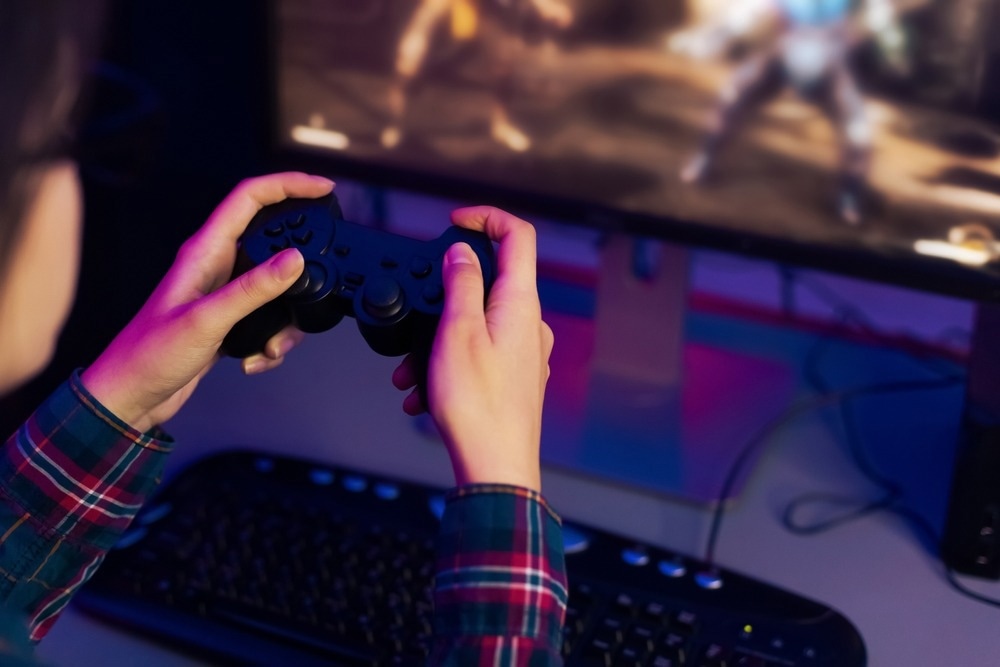Surgically implanted brain-computer interface enables precise finger control in paralysis patient, unlocking potential for social and leisure activities like video gaming
 Study: A high-performance brain–computer interface for finger decoding and quadcopter game control in an individual with paralysis. Image Credit: Prostock-studio/Shutterstock
Study: A high-performance brain–computer interface for finger decoding and quadcopter game control in an individual with paralysis. Image Credit: Prostock-studio/Shutterstock
In a study published in Nature Medicine, scientists have recently developed a brain-computer interface that can be implanted in the brain to continuously detect and decode finger movements in people with paralysis, allowing them to play video games.
Background
Severe motor impairment or paralysis is associated with a range of disabilities that can affect a person’s physical and mental well-being. In the United States, more than five million people live with paralysis.
A recent survey conducted in the United States finds that about 79%, 50%, and 63% of people with paralysis from spinal cord injury have unmet needs for peer support, leisure activities, and sports.
People with mild or moderate motor impairments who can manipulate a video game controller often use video games for social connectedness and a competitive outlet. However, people with severe motor impairments experience major challenges in playing video games, even with assistive or adaptive technologies. They often have to play video games at an easier level of difficulty or avoid multiplayer games with non-disabled players.
Brain-computer interface systems are gaining significant attention as potential interventions for restoring motor activities. These interfaces can be leveraged to help people with paralysis control video games and, more broadly, control digital interfaces for social networking and remote work.
Robotic arms have gained the highest attention in the field of motor brain-computer interfaces for reaching and grasping where fingers move as a group. However, interfaces designed to provide individual finger control would allow activities such as typing, playing a musical instrument, or manipulating a video game controller.
Study findings
In the current study, scientists developed a finger brain-computer interface that can continuously decode three independent finger groups. The thumb was decoded in two dimensions, ultimately providing four degrees of freedom.
The brain-computer interface was capable of continuously recording the electrical activity patterns of multiple neurons in the brain and translating these signals into complex movements.
Scientists implanted the interface in the left precentral gyrus of a person with tetraplegia (paralysis in the upper and lower body) due to spinal cord injury. The left precentral gyrus is a brain region responsible for controlling hand movement.
They recorded neuronal activities while the participant was observing a virtual hand performing various movements on a computer screen. They analyzed the recording using machine learning algorithms to identify the signals linked to specific finger movements.
The brain-computer interface system used these signals to accurately predict finger movements and subsequently facilitate the participant to control three highly distinct finger groups in a virtual hand, including two-dimensional thumb movements.
The interface system achieved a greater level of finger movement precision and degree of freedom than previously possible.
Scientists extended the application of this finger control to a video game. They used finger positions decoded by the interface to provide independent digital endpoints for controlling the speed and direction of a virtual quadcopter, which in turn allowed the participant to pilot the device through multiple obstacle courses as a part of a video game.
The participant expressed a sense of social connectedness, enablement, and recreation during brain-computer interface control of the quadcopter. He also highlighted the significance of individualizing fingers and expressed how a lack of individualization degrades performance.
Study significance
The study describes the development and validation of a high-performance, finger-based brain-computer interface system that can address many of the unmet needs of people with paralysis.
The majority of previous studies have focused on using brain-computer interfaces for two-dimensional click cursor control to regulate a quadcopter or a flight simulator. One such study investigating an electroencephalographic-controlled quadcopter has reported navigation through 3 rings in 4 minutes, as compared to 12 rings in able-bodied controls using a keyboard.
The current study, on the other hand, has reported that the brain-computer interface system allows navigation through 18 rings in less than 3 minutes at peak performance, indicating a 6-times increase in performance.
The system also allows spontaneous free-form flight through randomly appearing rings. This approach of using fine motor control for intracortical brain-computer interface-controlled video games can fulfill many unmet needs of people with paralysis.
Journal reference:
- Willsey MS, et al. A high-performance brain–computer interface for finger decoding and quadcopter game control in an individual with paralysis (2025). Nature Medicine. doi:https://doi.org/10.1038/s41591-024-03341-8